How Regular AC Maintenance Can Save You Money
Maintaining your air conditioner regularly is more than just a...
When it comes to keeping your Florida home comfortable, a reliable air conditioning system is a necessity, not a luxury. However, many homeowners don’t realize how much the quality of an installation affects the performance, efficiency, and lifespan of their system. A professional AC installation is about more than just placing a new unit—it’s a detailed process that requires planning, precision, and technical expertise. If you’re preparing for a new system, understanding what happens during a professional installation can help you know what to expect and ensure everything runs smoothly.
Before any work begins, a professional HVAC technician will perform an in-depth consultation and inspection. This step helps determine the right system for your home’s size, layout, and cooling demands. The technician will measure square footage, evaluate insulation, check existing ductwork, and assess window placement and sun exposure. These details help calculate your home’s cooling load—how much power the new system needs to effectively regulate indoor temperatures.
In Florida, where humidity and high temperatures are constant factors, this step is critical. An oversized unit will cool your home too quickly without properly dehumidifying it, leaving the air damp and uncomfortable. An undersized unit, on the other hand, will struggle to maintain consistent cooling, running constantly and increasing energy bills. The goal is to match your home with an AC unit that offers efficiency, comfort, and durability.
Once the assessment is complete, your HVAC contractor will recommend a system that fits your home’s requirements and budget. Most homeowners in Florida choose between a central air conditioner, a heat pump, or a ductless mini-split system. Each option has its own benefits. Central air systems are ideal for larger homes with existing ductwork. Heat pumps provide both heating and cooling, offering energy efficiency year-round. Ductless systems work well for homes without ducts or for cooling specific areas.
The technician will also discuss energy efficiency ratings, such as SEER2 (Seasonal Energy Efficiency Ratio). Higher SEER2 ratings indicate more efficient systems that can reduce your monthly energy costs. The selection phase may also include reviewing smart thermostat options, air purifiers, and humidity control accessories to enhance comfort and air quality.
On installation day, the crew will prepare the work area to ensure safety and minimize disruption. This includes laying protective coverings to prevent dirt or damage inside your home and clearing access to the existing equipment. If your old unit is still in place, it will need to be removed carefully and disposed of according to local environmental regulations.
Technicians will also check your electrical panel, wiring, and ductwork before the new system is installed. In some cases, upgrades may be needed to handle the power requirements of the new AC. This is especially true for older homes where wiring or circuit breakers might not meet current standards.
Removing your old air conditioner is not as simple as pulling it out and replacing it. Professionals follow a specific process to handle refrigerant safely and ensure no environmental contamination occurs. Federal law requires proper recovery of refrigerants before disposal, which licensed HVAC technicians are trained to perform. Once the refrigerant is removed, the old unit and components such as the evaporator coil, condenser, and air handler are taken out.
The removal process provides a chance to inspect hidden components, like ducts or the condensate drain line, for signs of wear or blockage. Addressing these issues during installation can prevent future problems.
Once the area is prepared, technicians begin setting up your new system. The installation involves several key steps:
Attention to detail during this stage determines how well the system will perform. Professional installers use calibrated tools and follow precise manufacturer specifications for refrigerant charging, pressure testing, and airflow balancing.
Once installation is complete, the technician will run a series of performance tests to confirm the system operates correctly. This includes checking the thermostat communication, measuring airflow, testing refrigerant pressure, and confirming that the system cycles on and off properly.
They’ll also inspect the temperature differential between the supply and return air vents to verify that the system is cooling effectively. Proper calibration ensures your AC doesn’t have to work harder than necessary, which can reduce wear and extend its lifespan.
Before leaving, your HVAC technician will walk you through the new system’s operation. This includes how to adjust the thermostat, maintain filters, and recognize warning signs that could indicate a problem. They’ll also go over warranty information and recommended maintenance schedules.
This step is essential because it helps homeowners understand how to keep their new system running efficiently. Regular maintenance—such as cleaning filters, inspecting coils, and scheduling annual tune-ups—can prevent many common issues and preserve warranty coverage.
It might be tempting to cut costs with a do-it-yourself approach or by hiring an unlicensed contractor, but professional installation makes a significant difference. Improper setup can lead to poor airflow, refrigerant leaks, electrical hazards, or voided warranties.
Licensed HVAC professionals not only have the technical expertise but also the necessary tools and certifications to handle refrigerants, electrical work, and load calculations safely. When you hire a qualified installer, you gain peace of mind knowing that your system is properly configured to deliver reliable cooling and long-term energy efficiency.
Many homeowners wonder how long the installation will take. Most standard AC replacements can be completed within one day, though larger or more complex projects—such as ductwork modifications—may take longer.
Another common concern is cost. While installation pricing depends on the system size, energy rating, and home requirements, investing in a professional job can save money over time through improved efficiency and fewer repairs.
Finally, homeowners often ask when the best time is to install a new system. In Florida, the cooler months are ideal since HVAC contractors have more availability, and you won’t have to endure high indoor temperatures during installation.
After your AC is installed, maintenance becomes your next priority. Schedule professional tune-ups at least once a year, preferably before the summer season. These visits allow technicians to check refrigerant levels, clean coils, test electrical connections, and ensure optimal performance.
You can also take simple steps on your own, such as replacing air filters every one to three months and keeping the outdoor unit clear of debris. These small actions help maintain efficiency and prevent avoidable issues.
A professional AC installation is one of the most important investments you can make in your home’s comfort. From the initial consultation to the final system check, every step is designed to ensure your air conditioner performs safely and efficiently. Choosing the right team for the job ensures that your system is installed according to industry standards, providing reliable cooling through Florida’s long, hot seasons.
When the time comes for a new installation, partnering with an experienced HVAC company ensures the work is done right the first time—giving you confidence, comfort, and lasting peace of mind.
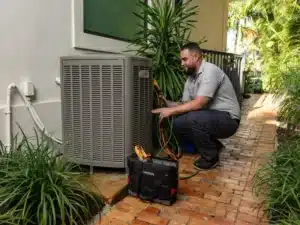
Maintaining your air conditioner regularly is more than just a...
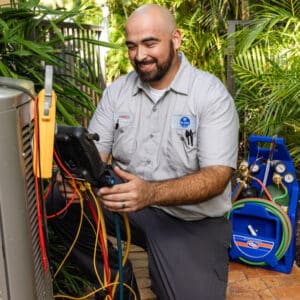
Florida homeowners rely on air conditioning more than most parts...
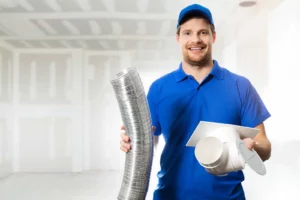
Indoor air quality is a major concern for many Florida...

Indoor air quality, often abbreviated as IAQ, plays a crucial...
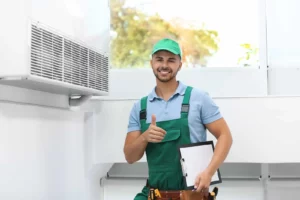
Installing a new HVAC system is a significant investment in...
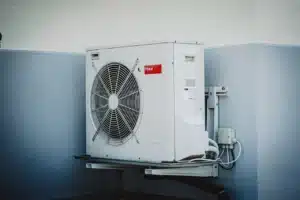
For many homeowners in Florida, the HVAC system is the...